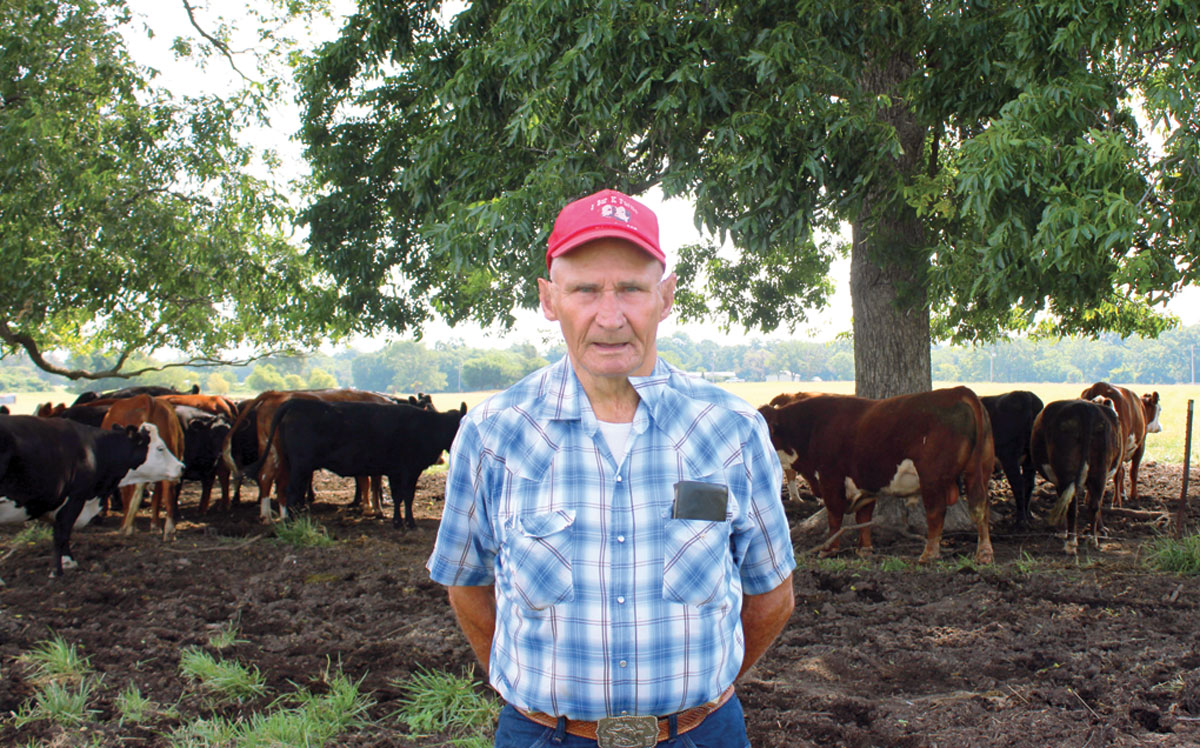
Jerry Arnold began raising Hereford cattle in 1950 and continues with the breed for the base of his herd
Jerry and Katherine Arnold, J Bar K Farms in Nevada Mo., have experienced many changes as they walked down life’s pathway together. One thing that has not changed is his admiration for Hereford cattle and the farming way of life.
Jerry spent his childhood on a farm near Pleasanton, Kan., where his family raised cattle, oats, barley and wheat. He started showing purebred Hereford calves in 1950.
“At that time Herefords were the big breed. Hereford is still my love,” he remarked.
Jerry and Katherine were married in 1964 and moved to Hume, Mo., in 1968 to help Katherine’s mother, Vergie Brooks, keep the operation running after her father, Russell, had a heart attack.
“We took over his farming and done farming of our own at the time,” Jerry said.
The Arnold’s ventured into the dairy business from 1970-1976. They milked 40 head of Holstein cows and farmed 200 acres of soybeans and milo just south of Hume. Even in the dairy business, Jerry used Hereford bulls on his Holstein cows.
They closed the dairy and moved to Nevada in 1977. Jerry had the opportunity to open a service station and Katherine continued to teach at Walker School. Jerry worked a variety of jobs and farmed on the side before retiring from the United States Postal Service 15 years ago.
Life took an unexpected turn when Katherine was involved in a health-altering accident which restricted her ability to be involved in the farm. Jerry had to make the hard decision to sell the 250 acres Katherine inherited from her family and half of their cows. He still owns 100 acres near Nevada and 160 acres west of Deerfield, Mo.
“We at one time had 150 cows. I am down to 72. I like to stay around 75 cows,” Jerry said.
He remains faithful to the Hereford breed even though his herd is now a mixture of red and black.
“I have some purebred Herefords and purebred Angus, too but basically just crossbred. I don’t register any of my cattle. I always have purebred Hereford bulls,” he said. He likes Herefords because they are calm, easy to handle and raise a good calf. He appreciates the Angus breed for the same reasons, plus they breed back well. He noted he seldom has to pull a calf.
“I can’t ever remember that I had one that was mean and ornery,” he exclaimed.
Jerry has both a spring and fall calving herd. He creep feeds, weans and vaccinates his calves before they are sold.
“I check them all whenever they are calving every day and sometimes two or three times a day,” he said.
Jerry has witnessed several shifts which he believes are for the betterment of the agriculture industry.
“The price of cattle is going through the roof here in the last three years or so. That in itself has made a big difference. There are more people and fewer cows than there used to be,” he explained.
He commends the introduction of fescue, a hardy fast-growing grass.
He also has seen an increase in hay quality since it became established in pastures.
“The grass itself has become better than what it was when I was a kid. We didn’t have fescue when I was a kid; we just had native grass with some clover in it,” Jerry recalled, adding he will sew clover into his fescue fields.
In the late spring and summer months, Jerry is found on his tractor mowing, raking and bailing hay. He will put up 600 large round bales each year.
“You can bale 600 big bales now and never get off the tractor or touch one of them. Little square bales are a lot of work, as a kid we hauled all summer long,” he said.
Round bales are more efficient and less labor intensive. He does see more waste compared to the small square bales.
He owns two balers, a belt baler and a chain baler. He favors the belt baler because it will produce the cleaner, tighter wrapped bales. He uses sisal baler twine because it is durable and biodegradable.
Jerry believes the biggest challenge facing young producers is the price tag on implements.
“The price of equipment is out of this world. Even used equipment is way up there,” he exclaimed.
His best piece of advice to other farmers and ranchers is based on his experience.
“Have a decent job to support your family. My 401K is my cows. When I had extra money well then that’s what I done, all my extra money went into my farming and that’s the way I got to be where I could do it full time,” Jerry concluded.






